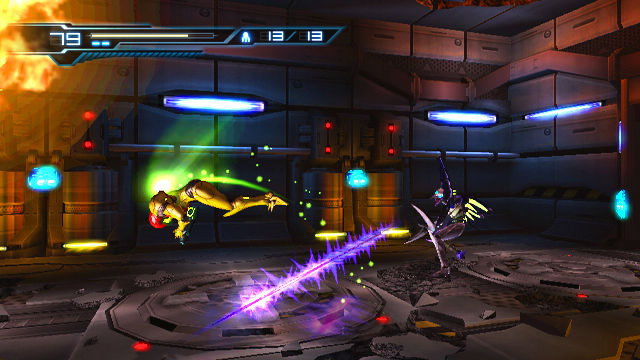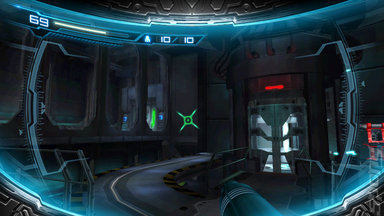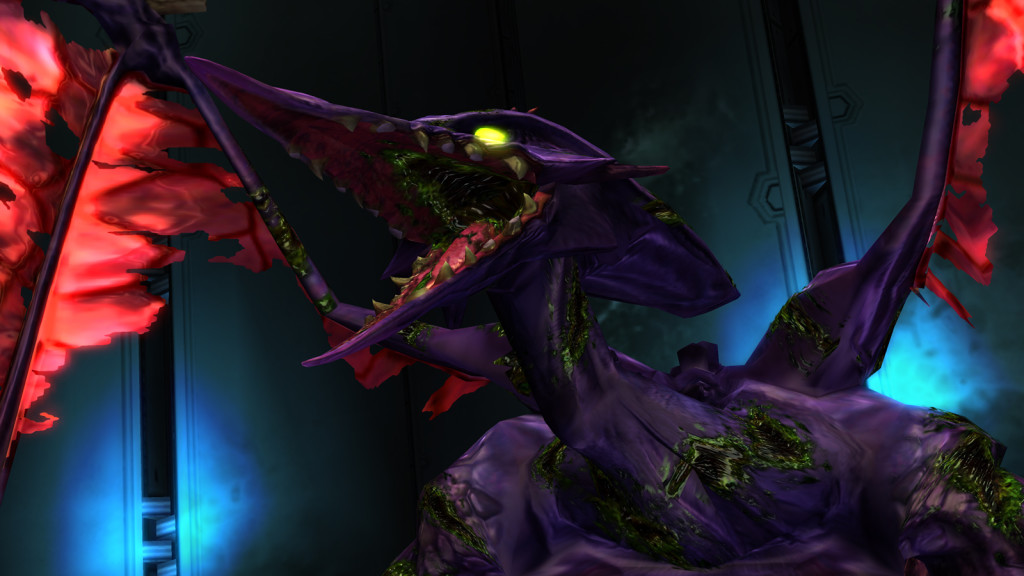Last updated on February 7, 2014
However, you don’t merely fire with whatever’s strongest. Each enemy requires a different approach, and not just in weapon choice. Some resist missiles until a weak point shows; others become angry if you use a particular weapon, developing an immunity to it. It works much more in Ninja Gaiden’s wheelhouse, with each enemy turning into a dexterity and timing-based puzzle which you need to figure out on the fly. New enemy combinations lead to new priotization. Multiple Space Pirates with differing weaknesses (one to charge beam, one to missiles) means full knowledge of your abilities becomes a requirement, a fun one at that.
Your charge beam turns into an incredibly useful weapon, as Samus can jump on an enemy’s head to deliver charged blasts to their face. Similar to Ninja Gaiden, Samus can also execute any enemy who’s stumbled to the ground by approaching them with a charged beam in some creatively animated death sequences. Hey, it’s a satisfying end to a brutal sequence.
To charge your beam, you could run around until your meter’s full, but where’s the fun in that? Other M, instead, wants you to learn its dodge system. Merely press a button in a direction when an attack will hit you to dodge, indicated by a satisfying green glow as Samus leaps from harm. However, and here’s the key, if you hold the shot button while dodging, it will fully charge the beam regardless of how much you did so before said dodge. You can imagine the significance of this mechanic: dodge and charge a LOT. You will always look outnumbered and isolated, a Metroid theme (at least in combat situations), and this ability gives you an edge against multiple enemies bearing down on your position.

In all of these events, they do not just throw quicktime events at you as in God of War; you establish when these cool things happen, and unleash the killing blow by releasing the shot button. This makes them into quicktime event-like setpieces without relinquishing the player’s control; most enemies will throw you off them if you wait too long, so it’s up to your good timing (and how much you charged in advance before initiating the sequence) rather than a canned sequence. This fixes one of the fundamental problems with quicktime events, and I’m glad to see an improvement.
Still, Other M must make compromises to fit into the “Metroid” mold, and sometimes its cinematic impulse gets the better of it. At times, the game forces you into Search mode to find something. What is that something? The game doesn’t bother to tell you! This remains the most frustrating part of Other M whenever it happens; it certainly does not help that the intended scannable area is incredibly small! Supposedly, you will learn a fact about the plot and then transition into a cutscene, but it merely stops the action for no good reason. It’s not challenging or interesting, just tedious, something akin to pixel hunting in an old SCUMM adventure game.

Because we speak of a Nintendo game here, combat eventually becomes far too easy in the latter part of the game for the purpose of accessibility (especially with upgrades). Once you get the Screw Attack, expect most enemies (except bosses) to fall near immediately at your force. That’s a notable trope of the Metroid series, put to good use here as always (as in, making you feel more powerful), but here the combat suffers without exploration elements to buttress the game towards the back end.
Even then, combat becomes fundamentally repetitive with the limited number of options, even if context sensitive animations are unbelievably cool and interactive. As well, the dodging provides too large of a window for button timing. You can often buffer dodges by tapping a direction repeatedly rather than actually pressing it at the right time, and I found myself doing this for charged shots rather than running away in most situations.
Bosses fail to provide as great a challenge as you’d suspect once you find the right pattern. Frankly, I had hoped Ridley (SPOILERS I GUESS) would present a challenge, but anyone competent with the controls and learning the correct order to use abilities will conquer him on the first try. Disappointing, to say the least. Earlier Metroids forced you to use most of your resources to take bosses down, meaning upgrades actually meant something. As a particular example, Super Metroid’s Ridley takes a massive number of missiles to down, usually absorbing all of your Super Missile stock (somewhere in the 20-30 range) and most of your missiles (probably 200, if I remember correctly). That Ridley here falls in a simple charged shot, then Super Missile combo three times in a row certainly isn’t quite the same.

Since Other M’s combat focus would certainly reduce your stock of limited-use weapons, you can recharge it at any time provided you can stand still and hold the Wiimote up for five seconds – a possibility in most boss fights. When you basically retain access to an unlimited number of missiles and charge shots, it does drag the bosses down quite a bit. If anything, I’ll complain about how the last boss (before the credits) forces you to use an ability you didn’t know you actually had, explained in a tutorial eight hours before. That sort of element may make sense from a story standpoint, but I couldn’t figure it out without looking it up online.
As you might have heard, Samus’ abilities unlock when her superior officer/father figure/mentor Adam Malkovich (first introduced in Metroid Fusion), whose team is also on the station, tells her so. Much of the story plays out as an internal monologue most times in a monotone Samus voice in which she describes her past. You learn that she’s rebellious and equally dependent on others for authority and guidance. Whether or not you think this is a positive/negative portrayal of women, your perceptions and preconceived notions of her may be changed, so be forewarned. As the story progresses, she eventually learns to fend for herself and activate her own weapon upgrades, thus justifying the silly part at the end with the locked ability.
Some people like this, and other hate this aspect of Other M (it removes her autonomy, or doesn’t), but it performs the same function – meting out upgrades – as it did before in a way that makes sense for both a combat-centric Metroid and the plot. However, the inconsistency mentioned beforehand just wrecks the whole idea for me, when I found myself seconds away from defeating the last boss and unable to figure out why I was dying for fifteen minutes.
If anything, this particular instance represents a great deal of what went wrong with Other M – it attempts to bridge the adventurous style of Metroid with the exciting skill-based combat. Does it succeed brilliantly on a number of levels? Absolutely! But its flaws look stunningly horrific, magnified in light of the quality inherent within the rest of the product. Honestly, I considered knocking the game down another star just for the scanning sequences and the last boss foolishness alone. Still, I believe the fundamentals of the game remain exciting throughout, and though we may never see another game in this vein, it certainly brought the series back into more traditional third-person action waters than the Prime Trilogy.
All in all, I recommend it.
